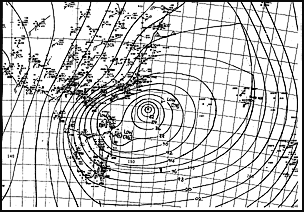25 years since the Sydney to Hobart tragedy
Boxing Day 2023 marks 25 years since the start of the 1998 Sydney to Hobart Yacht Race – an event which will forever be synonymous with tragedy.
Six sailors lost their lives and another 55 were saved in what became the largest search and rescue operation in Australia's peacetime maritime history.
The race started in perfect conditions with sunny skies and north to northeasterly breezes which propelled the race leaders down the east coast towards Hobart in near-record time. Indeed the largest maxi yachts would sail so fast that they avoided the worst of the weather that smashed the majority of the fleet on day two of the race.
But most of the 115 starters would feel the full fury of the storm, with only 44 finishing and 71 retiring. Five of the 71 yachts that retired were lost at sea.

Image: The BoM synoptic chart at 3PM on December 27, 1998, showing the intense low centred over eastern Bass Strait. Source: Dick's blog: the blog of respected meteorologist Dick Whitaker.
There's a fantastic pair of YouTube videos which capture the full story of the race (you can watch the first one here and the second one here).
In the first video, a young meteorologist called Mark Hardy offers some fascinating insights. Mark is the man who founded Weatherzone, which coincidentally also happened 25 years ago.

Image: As ever, his forecasts were right on the mark. Source: Still image taken from the official YouTube channel for the Cruising Yacht Club of Australia, home of the Rolex Sydney Hobart Yacht Race.
"The forecast is for fairly light to moderate northeasterly winds down the coast around the 15 to 20 knot mark, but when the boats reach Bass Strait, they'll encounter a very strong change from the west or southwest and winds will be up around the 40 knot mark with that change," Hardy said in a forecast used in the early part of the first video as the fleet sailed out the heads of Sydney Harbour.
For those who don't understand "knots" (or nautical miles per hour), 40 knots equates to 74/kmh. So those were some scarily strong winds in the forecast, but things were about to get a whole lot more scary.
"We've just received the latest computer model guidance which came out around one o'clock this afternoon and it shows that the low will be very intense and will develop in Bass Strait and it looks now like winds will be up around the 45 to 55 knot mark [83 to 102 km/h], and a storm warning has been issued for winds of that strength," Hardy said in his next forecast.
In the video, the narrator says "the crews could be excused for complacency as the last five Sydney to Hobarts had started with similar storm warnings". That's not completely accurate. Yes, there had been storm warnings. But there hadn't been warnings of such a strong storm lying directly in the path of the fleet's small and middle-sized boats.
By midday of day two, the storm had arrived.
"It was intense and awesomely frightening, gusting as far ocasionally as 85 knots [157 km/h]," Steve Kulmar, helmsman of Sword of Orion said. Kulmar would eventually see his crewmate Glyn Charles swept away, never to be seen again. Charles was a British sailor who had competed at the 1996 Olympics.

Image: Mountainous seas destroyed or sank numerous yachts. Source: iStock.
"It was a low pressure system that formed around a front. The actual dynamics of the storm were quite complex. It was related to the jet stream and a whole lot of cold air coming up through southern Victoria caused a rapid intensification of the system," Hardy explained.
By the afternoon of day two, the rescue operation was in full swing. Some of the footage of helicopters hovering in wild winds over mountainous waves is incredible. The bravery and skill of the helicopter pilots and rescue crews is one of the forgotten stories of this disaster.
In the end, the 1998 Sydney to Hobart tragedy can be attributed to the fact that the worst of the weather occurred in Bass Strait just as the fleet was crossing that stretch of water between Tasmania and Victoria.
"Bass Strait is notorious for strong storms and a lot of it is related to the shape of the ocean bottom, the ocean currents... they all combine together to make a storm particularly ferocious, particularly in eastern Bass Strait," Hardy said.
"This was a storm that you'd only see once every five or ten years."
The cold air from the storm would deliver an unusually heavy summer snowfall to the Australian Alps. While the unseasonable snow soon melted, the memory of the 1998 Sydney to Hobart lives on to this day, and always will.
The six sailors who died were:
- Phillip Charles Skeggs (Business Post Naiad, drowned)
- Bruce Raymond Guy (Business Post Naiad, heart attack)
- John Dean, James Lawler and Michael Bannister (WInston Churchill, all drowned)
- Glyn Charles (Sword of Orion, drowned)
Good luck to all competitors this year, and most importantly, a safe journey.